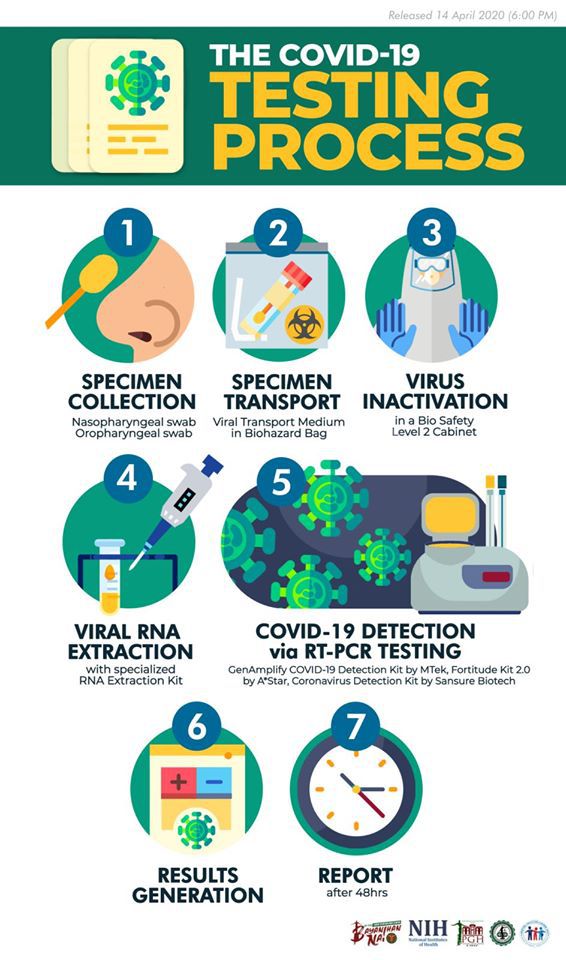
A COVID-19 test kit explainer was released by the University of the Philippines-Philippine General Hospital (UP-PGH) as the Philippines started mass testing in communities.
The UP-PGH released the COVID-19 Testing Process Infographic on April 14, 2020, as the country escalated its mass testing to have a better overview of coronavirus infections in the population. The Philippine government plans to complete 13,000-20,000 tests by April 27.
The UP-PGH is a government-designated referral center for COVID-19 patients and is using the UP National Institutes of Health-developed GenAmplify COVID-19 Diagnostic Kit manufactured by Manila HealthTek.
The UP-PGH COVID-19 Infographic explains the 7 steps of the testing process using the reverse-transcriptase polymerase chain reaction (RT-PCR) test:
- Health workers use six-inch-long swabs to take samples of biological material from the back of the nose and throat.
- Collected specimen is then secured in a biohazard bag for transport to approved testing laboratories.
- Samples sent to testing laboratories are placed in Bio Safety Level 2 Cabinet, to ensure safety and prevention of contamination.
- Samples are subjected to Viral RNA Extraction, where detergents are introduced to strip samples from mucus and live cells, as well as the RT enzyme to convert viral RNA to DNA. RNA is the genetic code of viruses, and the PCR test can only process DNA.
- Samples are then subjected to the PCR test, where certain DNA that bind to viral DNA is added. If a viral DNA is found, a chain reaction repeatedly copies the viral DNA to prove its presence in the sample.
- These samples are then checked to confirm the results.
- The results are reported back to waiting patients. The entire process, and thus wait time, can take up to 48 hours.
The Department of Health states that the criteria that qualify people for priority testing are people or medical workers with significant travel history or exposure, and who exhibit critical symptoms of the disease; as well as those who show milder symptoms.
Also prioritized are those with compromising pre-existing health conditions, the elderly, and pregnant women who have shown mild symptoms.
Those who are not of that criteria can ask to be screened by medical professionals to determine if they’re eligible for testing.
The UP and DOST-developed RxBox vital signs monitors for COVID-19 patients are also now in use at the PGH.
The UP-PGH had also recently set up the Tele-Kumusta electronic visit to cheer up COVID-19 patients, families.
SHARE THIS STORY to help people understand the COVID-19 testing process and SEND CHEERS to UP PGH for releasing their infographic.
Want to know how to be a Proud Pinoy? Like, Follow, Subscribe to GoodNewsPilipinas.com and our socials Facebook, Twitter, Instagram, Good News Pilipinas! TV on YouTube, for new story notifications and e-mail newsletters for updates on more Filipino Pride stories.










